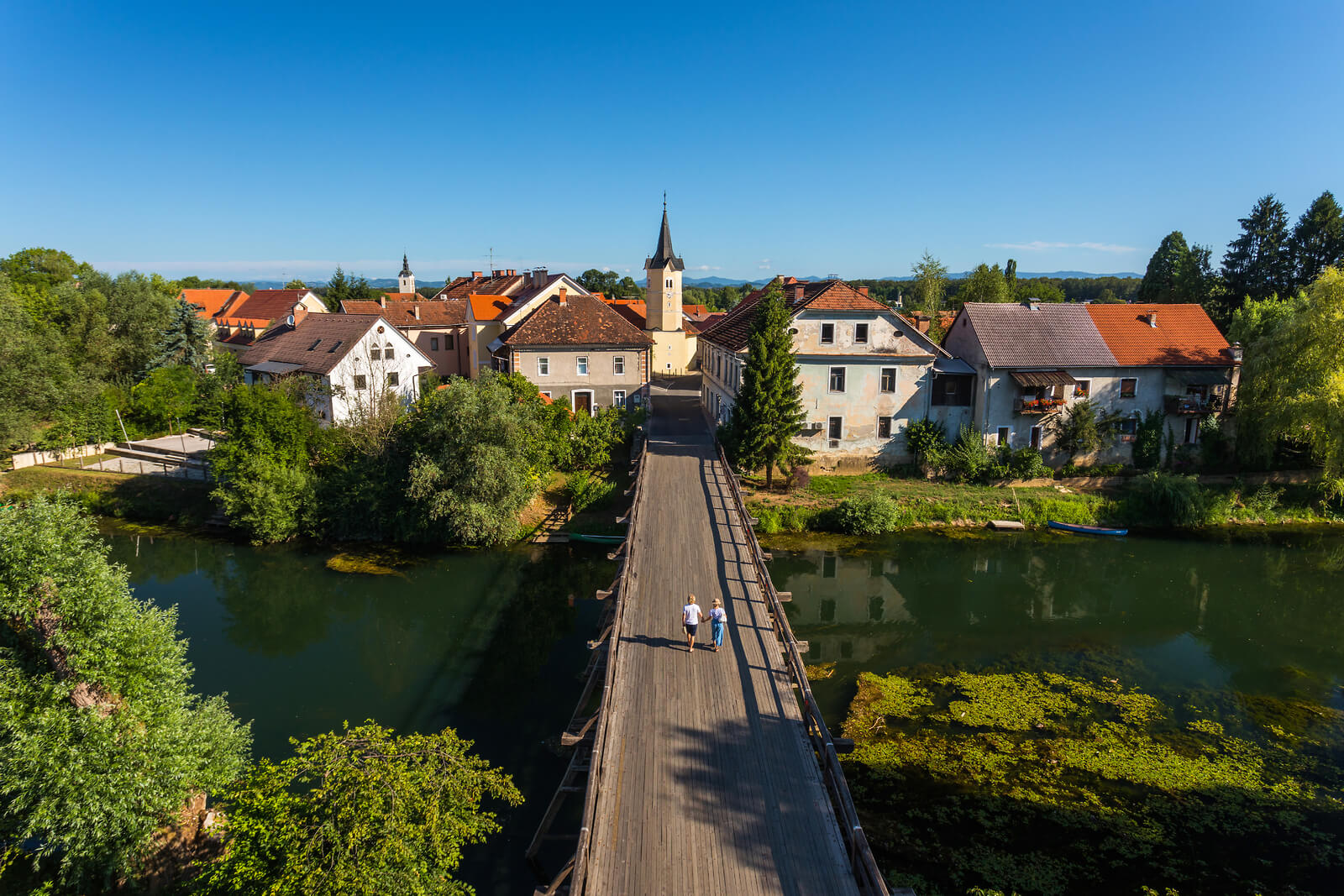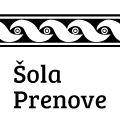Through the only town on a river island
Stroll through the unique town. Continue to the remarkable gallery in the monastery. Wander among a hundred wooden sculptures. Turn to the cave at the foot of the Gorjanci hills.
Across the bridge to the town on the island
Take a walk through the centre of Kostanjevica, the smallest, but also the oldest town in Dolenjska, from the parking lot at the bus station. Take the Tercialski Bridge (1), designed by the famous architect Jože Plečnik, and arrive to the island on the Krka River. In Oražnova ulica streets that the locals call Mali plac, turn left towards the parish church of St. James (2), which is the oldest preserved building in the town.
A Tip: You can enjoy a good coffee and a cake in the Štraus café behind the church walls. The cake combines local flavours of: buckwheat, nuts, chestnuts, cviček wine, elderberry, raspberry and much more. Nearby is the north bridge, which gets you to the motorhome parking space.
Among houses on Veliki plac
Continue your walk along Ulica talcev street, which the locals call Veliki plac. Go to Iva’s House (3), the largest burgher house on the island of the Krka. Continue past the Gorjup house (4), where the painter Jože Gorjup was born. His frescoes also adorn the next point of interest – the Church of St. Nicholas (5). Kambičev trg square is where Mali and Velik plac meet. You will find Tourist information centre nearby (6). Here you can choose souvenirs or find inspirations for the experiences of the town and Dolenjska.
From the island to the famous gallery
Cross the Krka at the south bridge (7) and turn right onto Ljubljanska ulica street. After the apartment block, turn onto Grajska cesta road. The view of the Gorjanci and the wine-growing hills accompanies you on the way to the former Cistercian monastery (8). It has housed the Božidar Jakac Gallery (9) since 1974 and many works of art by important Slovenian artists.
A Tip: In the basement of the gallery is Cvičkova klet wine cellar, where you can arrange for wine tasting of cviček – wine with recognized traditional origin, and learn about wine cellars along the way.
Among the streams to the big mosaic
From the parking lot of the monastery complex, the gardens of which are adorned by the Forma Viva park (10), turn left. Cross the small bridge over the Obrh stream and continue along the wooden sculptures on the macadam road. When you cross the Studena stream, turn left towards the cemetery and the Jože Gorjup Primary School (11). On the front façade, “The Battle of the Krško Field” mosaic is visible from afar. You can also see the gallery collection in the school by prior arrangement.
A Tip: If you turn right after the bridge over the Studena stream, you will find yourself at the Kostanjevica cave in a matter of minutes. Have a look at the Suggestions for a hike section.
Back to the island
From the school, return to the old town on the island via the south bridge. On Mali plac i.e. Oražnova ulica street., look at the Oražen House (12) from 1831. In front of it stands the statue of Ivan Oražen, a doctor and one of the initiators of the Medical Faculty in Ljubljana. Go past the Ministerial mansion (13) with elements of the Middle Ages and Baroque, and arrive back at the wooden Tercialski Bridge, where you began your journey through Kostanjevica na Krki.
A Tip: In Oražnova ulica enjoy a pizza and craft beer in Kralj Matjaž Pizzeria. On the other side of the Tercialski Bridge, just a few minutes’ walk from the parking lot, you can treat yourself to lunch with Dolenjska dishes at the Žolnir Inn.
Suggestions for a hike
The Kostanjevica cave
From the small wooden bridge over the Studena stream, which you crossed after returning from the Božidar Jakac Gallery, it is only a 5-minute walk to the foot of the Gorjanci hills and the Kostanjevica Cave. Here, groundwater currents have been creating calc-sinter formations of fairy-tale shapes for thousands of years. In the cave, which is more than two kilometres long, 300 meters are illuminated and arranged for tourist viewing. The path through the cave is suitable for children and older visitors as well. It is open from April to the end of October and has inner temperature of 12 degrees Celsius at all times.
More information: TIC Kostanjevica na Krki

1. The Tercijalski bridge
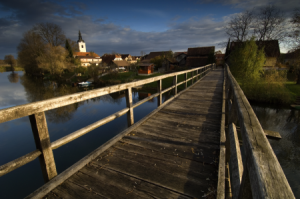
The famous architect Jože Plečnik, who was friends with the Kostanjevica pharmacist Emilija Fon for many years, designed the original bridge. The bridge was originally made up of timber from the cable lift used for transporting timber from the Gorjanci hills. It was built in the years 1955 – 56. Pedestrians and cyclists use it again after the renovation in 1997.
Ulica talcev
2. The church of St. James
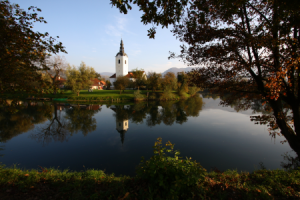
In the parish church from the 13th century with Baroque elements that were added later on, a nave with stepped, deepened and painted Romanesque portals, which are among the highest quality stone monuments in Slovenia, has been preserved.
Ulica talcev 31
3. Iva’s house - Vila Castanea
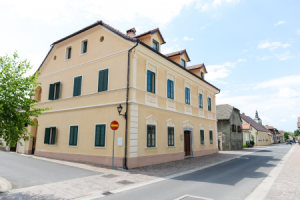
The largest burgher house on the island, built in 1878, boasts a richly decorated front façade, an arched ground floor, local paving stones and an inner courtyard in the shade of a mighty chestnut tree. The house, which used to be an inn, now offers tourist accommodation.
Ulica talcev 9, T: 69 927 593
4. The Gorjup house
Jože Gorjup (1907 – 1932), a painter, sculptor and graphic artist, born in this house, returned to his hometown after studying in Zagreb and Florence. By painting St. Nicholas’s church he co-created the rebirth of Slovenian church painting. He also sculpted a statue of Jesus for the church from burnt clay. His oil paintings are exhibited in the Božidar Jakac Gallery.
Ulica talcev 8
5. St. Nicholas’s church
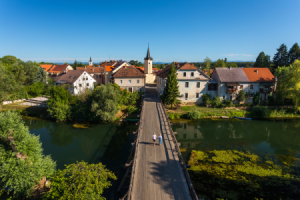
The Gothic presbytery of the church, first mentioned in the 16th century, has boasted frescoes by Jože Gorjup since 1931. Many consider them the most beautiful recent church paintings in Slovenia. The bell tower with its new bronze bells got its neo-Gothic appearance in the early 20th century.
at Oražnova ulica and Ulica talcev
6. Tourist Information Centre
Since 2021, the Tourist Information Centre has been located in a new location, in a multi-apartment building on the premises of the former Town Market. The locals refer to it as “the old post office” because it used to be here. The premises are owned by the Municipality of Kostanjevica na Krki. Here you can get all the information about the town and arrange for guided tours.
Kambičev trg 5, T: 07 49 88 152
7. The South bridge
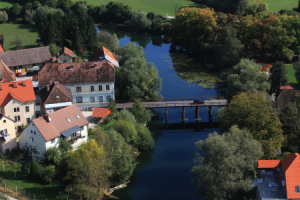
Kostanjevica is a unique town on a river island. It is accessible via three bridges: the Tercijalski Bridge, the north and the south Bridges. The bridges were built with English oak from the nearby Krakovo forest. In the past, bridge piers were driven into the river by hand.
Kambičev trg
8. The Cistercian monastery of Kostanjevica
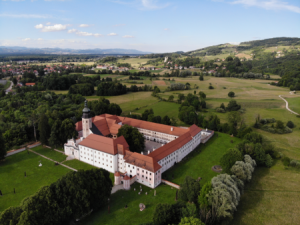
The monastery, founded in 1234 by the Duke of Carinthia Bernard of Spanheim, was a religious, cultural and economic centre along the lower reaches of the Krka River in the 13th and 14th centuries. After the dissolution of the monastery in the 18th century, the complex underwent several alterations. Two tracts of a large arcaded courtyard, which is among the largest in Central Europe, are from this time.
Grajska cesta 45
9. The Božidar Jakac Gallery
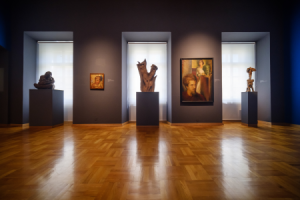
One of the largest Slovenian galleries has been operating on the premises of the former Cistercian monastery since 1974. The permanent collection presents work of art by a painter and graphic artist Božidar Jakac (1899 – 1989) and the works by Slovenian expressionists. Here, you can also see the Pleterje collection of old masters, which is owned by the nearby Pleterje Carthusian Monastery. Occasional exhibitions of top domestic and foreign artists are on display in the lapidary and in the former convent church.
Grajska cesta 45, T: 07 49 88 140
Forma viva
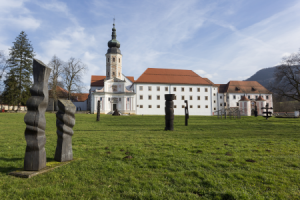
In the gardens of the monastery complex, more than a hundred sculptures created at the international sculpture symposium Forma Viva, which has been running since 1961, are exhibited outdoors. Sculptures by artists from all over the world are created exclusively from the oak wood typical of the area.
Grajska cesta
OThe Jože Gorjup primary school
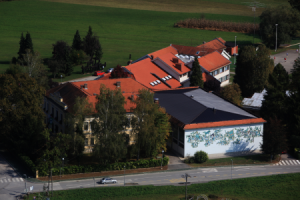
The façade of the school, built in 1906, features the largest mosaic in Central Europe. It depicts the Battle of the Krško Field from the time of the Peasants’ Revolts of 1573. The painter Ivan Seljak-Čopič and the mosaic artist Alfio Tambosso – Ultra, created the mosaic in 1962. The school houses the Jože Gorjup Gallery and a selection of statues, paintings, drawings and graphics from the extensive international collection of the Božidar Jakac Gallery. Visiting the gallery is possible by prior arrangement.
Gorjanska cesta 2, T: 07 48 100 13
The Oražen house
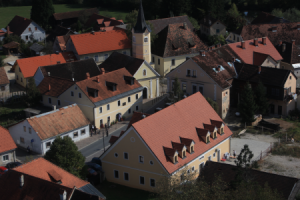
Ivan Oražen (1869–1921) was born in Kostanjevica. He was a doctor, surgeon and obstetrician and the first head of the Yugoslav Sokolska zveza Sports Association. He was one of the initiators of the establishment of the Medical Faculty in Ljubljana and later its greatest patron. He left his property to both the faculty and the Oražen student dormitory. Dean insignia of the faculty are made from the Oražen treasure (gold, silver, jewellery). Oražen’s bust, made by the sculptor Stane Jarm and the architect Boris Kobe, stands in front of the house.
Oražnova ulica 2
The Ministerial manor
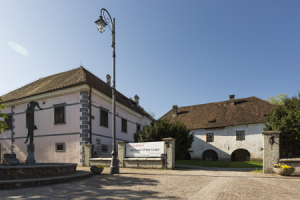
The origins of the most important preserved secular building in the town date back to the 16th century. After the big fires in the 16th and 17th centuries, the manor got its south and west tracts with arcades. In the 18th century, the Kostanjevica monastery took care of the construction of the eastern tract and St. Anne’s chapel. When the Cistercian monastery was abolished, the town opened a new rectory and a school in the building with an additional staircase. In 1958, it was renamed the Lamut Art Salon, which boasted an exhibition space up until 2020. The Tourist Information Centre also operated here for three years. The building was damaged in the 2020 earthquake and is now awaiting renovation.
Oražnova ulica 5
- 11. The Tercijalski bridge
- 22. The church of St. James
- 33. Iva’s house - Vila Castanea
- 44. The Gorjup house
- 55. St. Nicholas’s church
- 66. Tourist Information Centre
- 77. The South bridge
- 88. The Cistercian monastery of Kostanjevica
- 99. The Božidar Jakac Gallery
- 10Forma viva
- 11OThe Jože Gorjup primary school
- 12The Oražen house
- 13The Ministerial manor


